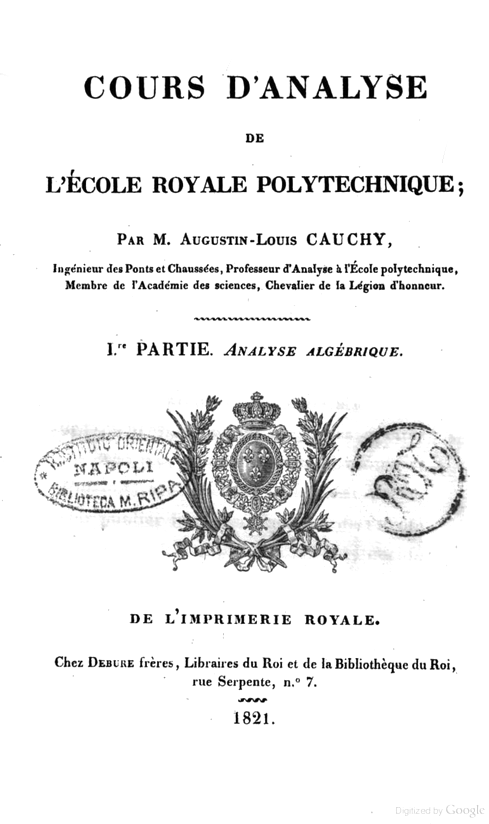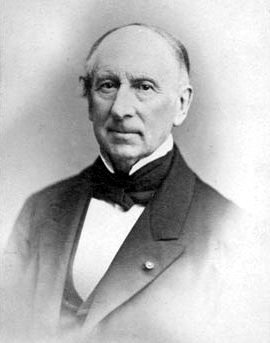|
Cours D'Analyse
''Cours d'Analyse de l’École Royale Polytechnique; I.re Partie. Analyse algébrique'' is a seminal textbook in infinitesimal calculus published by Augustin-Louis Cauchy in 1821. The article follows the translation by Bradley and Sandifer in describing its contents. Introduction On page 1 of the Introduction, Cauchy writes: "In speaking of the continuity of functions, I could not dispense with a treatment of the principal properties of infinitely small quantities, properties which serve as the foundation of the infinitesimal calculus." The translators comment in a footnote: "It is interesting that Cauchy does not also mention limits here." Cauchy continues: "As for the methods, I have sought to give them all the rigor which one demands from geometry, so that one need never rely on arguments drawn from the generality of algebra." Preliminaries On page 6, Cauchy first discusses variable quantities and then introduces the limit notion in the following terms: "When the values ... [...More Info...] [...Related Items...] OR: [Wikipedia] [Google] [Baidu] |
Cauchy Cours D'Analyse 1821 Title Page
Baron Augustin-Louis Cauchy (, ; ; 21 August 178923 May 1857) was a French mathematician, engineer, and physicist who made pioneering contributions to several branches of mathematics, including mathematical analysis and continuum mechanics. He was one of the first to state and rigorously prove theorems of calculus, rejecting the heuristic principle of the generality of algebra of earlier authors. He almost singlehandedly founded complex analysis and the study of permutation groups in abstract algebra. A profound mathematician, Cauchy had a great influence over his contemporaries and successors; Hans Freudenthal stated: "More concepts and theorems have been named for Cauchy than for any other mathematician (in elasticity alone there are sixteen concepts and theorems named for Cauchy)." Cauchy was a prolific writer; he wrote approximately eight hundred research articles and five complete textbooks on a variety of topics in the fields of mathematics and mathematical physics. ... [...More Info...] [...Related Items...] OR: [Wikipedia] [Google] [Baidu] |
Versine
The versine or versed sine is a trigonometric function found in some of the earliest (Sanskrit ''Aryabhatia'', Section I) s. The versine of an angle is 1 minus its cosine. There are several related functions, most notably the coversine and haversine. The latter, half a versine, is of particular importance in the of navigation. Overview The versine[...More Info...] [...Related Items...] OR: [Wikipedia] [Google] [Baidu] |
Calculus
Calculus, originally called infinitesimal calculus or "the calculus of infinitesimals", is the mathematics, mathematical study of continuous change, in the same way that geometry is the study of shape, and algebra is the study of generalizations of arithmetic operations. It has two major branches, differential calculus and integral calculus; the former concerns instantaneous Rate of change (mathematics), rates of change, and the slopes of curves, while the latter concerns accumulation of quantities, and areas under or between curves. These two branches are related to each other by the fundamental theorem of calculus, and they make use of the fundamental notions of convergence (mathematics), convergence of infinite sequences and Series (mathematics), infinite series to a well-defined limit (mathematics), limit. Infinitesimal calculus was developed independently in the late 17th century by Isaac Newton and Gottfried Wilhelm Leibniz. Later work, including (ε, δ)-definition of ... [...More Info...] [...Related Items...] OR: [Wikipedia] [Google] [Baidu] |
Mathematics Of Infinitesimals
Mathematics is a field of study that discovers and organizes methods, theories and theorems that are developed and proved for the needs of empirical sciences and mathematics itself. There are many areas of mathematics, which include number theory (the study of numbers), algebra (the study of formulas and related structures), geometry (the study of shapes and spaces that contain them), analysis (the study of continuous changes), and set theory (presently used as a foundation for all mathematics). Mathematics involves the description and manipulation of abstract objects that consist of either abstractions from nature orin modern mathematicspurely abstract entities that are stipulated to have certain properties, called axioms. Mathematics uses pure reason to prove properties of objects, a ''proof'' consisting of a succession of applications of deductive rules to already established results. These results include previously proved theorems, axioms, andin case of abstraction ... [...More Info...] [...Related Items...] OR: [Wikipedia] [Google] [Baidu] |
Springer Science+Business Media, LLC
Springer Science+Business Media, commonly known as Springer, is a German multinational publishing company of books, e-books and peer-reviewed journals in science, humanities, technical and medical (STM) publishing. Originally founded in 1842 in Berlin, it expanded internationally in the 1960s, and through mergers in the 1990s and a sale to venture capitalists it fused with Wolters Kluwer and eventually became part of Springer Nature in 2015. Springer has major offices in Berlin, Heidelberg, Dordrecht, and New York City. History Julius Springer founded Springer-Verlag in Berlin in 1842 and his son Ferdinand Springer grew it from a small firm of 4 employees into Germany's then second largest academic publisher with 65 staff in 1872.Chronology ". Springer Science+Business Media. In 1964, Springer expanded its business internationally, ... [...More Info...] [...Related Items...] OR: [Wikipedia] [Google] [Baidu] |
Archive
An archive is an accumulation of historical records or materials – in any medium – or the physical facility in which they are located. Archives contain primary source documents that have accumulated over the course of an individual or organization's lifetime, and are kept to show the function of that person or organization. Professional archivists and historians generally understand archives to be records that have been naturally and necessarily generated as a product of regular legal, commercial, administrative, or social activities. They have been metaphorically defined as "the secretions of an organism", and are distinguished from documents that have been consciously written or created to communicate a particular message to posterity. In general, archives consist of records that have been selected for permanent or long-term preservation on grounds of their enduring cultural, historical, or evidentiary value. Archival records are normally unpublished and almost al ... [...More Info...] [...Related Items...] OR: [Wikipedia] [Google] [Baidu] |
Neighborhood (mathematics)
In topology and related areas of mathematics, a neighbourhood (or neighborhood) is one of the basic concepts in a topological space. It is closely related to the concepts of open set and interior. Intuitively speaking, a neighbourhood of a point is a set of points containing that point where one can move some amount in any direction away from that point without leaving the set. Definitions Neighbourhood of a point If X is a topological space and p is a point in X, then a of p is a subset V of X that includes an open set U containing p, p \in U \subseteq V \subseteq X. This is also equivalent to the point p \in X belonging to the topological interior of V in X. The neighbourhood V need be an open subset X, but when V is open in X then it is called an . Some authors have been known to require neighbourhoods to be open, so it is important to note conventions. A set that is a neighbourhood of each of its points is open since it can be expressed as the union of open se ... [...More Info...] [...Related Items...] OR: [Wikipedia] [Google] [Baidu] |
Intermediate Value Theorem
In mathematical analysis, the intermediate value theorem states that if f is a continuous function whose domain contains the interval , then it takes on any given value between f(a) and f(b) at some point within the interval. This has two important corollaries: # If a continuous function has values of opposite sign inside an interval, then it has a root in that interval (Bolzano's theorem). # The image of a continuous function over an interval is itself an interval. Motivation This captures an intuitive property of continuous functions over the real numbers: given ''f'' continuous on ,2/math> with the known values f(1) = 3 and f(2) = 5, then the graph of y = f(x) must pass through the horizontal line y = 4 while x moves from 1 to 2. It represents the idea that the graph of a continuous function on a closed interval can be drawn without lifting a pencil from the paper. Theorem The intermediate value theorem states the following: Consider an interval I = ,b/math> of ... [...More Info...] [...Related Items...] OR: [Wikipedia] [Google] [Baidu] |
Integer
An integer is the number zero (), a positive natural number (, , , etc.) or a negative integer with a minus sign ( −1, −2, −3, etc.). The negative numbers are the additive inverses of the corresponding positive numbers. In the language of mathematics, the set of integers is often denoted by the boldface or blackboard bold \mathbb. The set of natural numbers \mathbb is a subset of \mathbb, which in turn is a subset of the set of all rational numbers \mathbb, itself a subset of the real numbers \mathbb. Like the natural numbers, \mathbb is countably infinite. An integer may be regarded as a real number that can be written without a fractional component. For example, 21, 4, 0, and −2048 are integers, while 9.75, , and are not. The integers form the smallest group and the smallest ring containing the natural numbers. In algebraic number theory, the integers are sometimes qualified as rational integers to distinguish them from the more general algebraic ... [...More Info...] [...Related Items...] OR: [Wikipedia] [Google] [Baidu] |
Simon Antoine Jean L'Huilier
Simon Antoine Jean L'Huilier (or L'Huillier) (24 April 1750 in Geneva – 28 March 1840 in Geneva) was a Swiss mathematician of French Huguenot descent. He is known for his work in mathematical analysis and topology, and in particular the generalization of Euler's formula for planar graphs. He won the mathematics section prize of the Berlin Academy of Sciences for 1784 in response to a question on the foundations of the calculus. The work was published in his 1787 book ''Exposition elementaire des principes des calculs superieurs''. (A Latin version was published in 1795.) Although L'Huilier won the prize, Joseph Lagrange, who had suggested the question and was the lead judge of the submissions, was disappointed in the work, considering it "the best of a bad lot." Lagrange would go on to publish his own work on foundations. L'Huilier and Cauchy L'Huilier introduced the abbreviation "lim" for limit that reappeared in 1821 in Cours d'Analyse by Augustin Louis Cauchy, who ... [...More Info...] [...Related Items...] OR: [Wikipedia] [Google] [Baidu] |
Vercosine
The versine or versed sine is a trigonometric function found in some of the earliest ( Sanskrit ''Aryabhatia'', Section I) trigonometric tables. The versine of an angle is 1 minus its cosine. There are several related functions, most notably the coversine and haversine. The latter, half a versine, is of particular importance in the haversine formula of navigation. Overview The versine[...More Info...] [...Related Items...] OR: [Wikipedia] [Google] [Baidu] |
Coversine
The versine or versed sine is a trigonometric function found in some of the earliest (Sanskrit ''Aryabhatia'', Section I) trigonometric tables. The versine of an angle is 1 minus its cosine. There are several related functions, most notably the coversine and haversine. The latter, half a versine, is of particular importance in the of navigation. Overview The versine[...More Info...] [...Related Items...] OR: [Wikipedia] [Google] [Baidu] |




